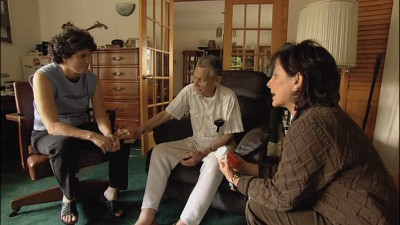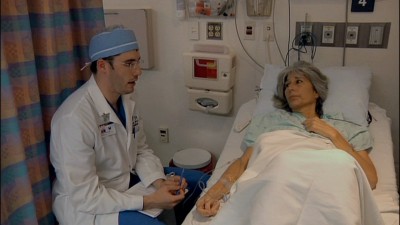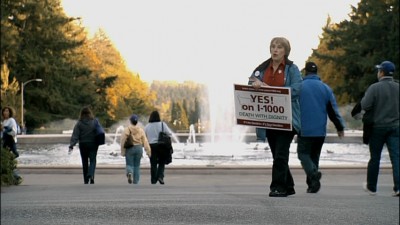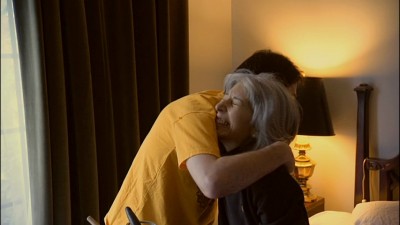| Reviews & Columns |
|
Reviews DVD TV on DVD Blu-ray 4K UHD International DVDs In Theaters Reviews by Studio Video Games Features Collector Series DVDs Easter Egg Database Interviews DVD Talk Radio Feature Articles Columns Anime Talk DVD Savant Horror DVDs The M.O.D. Squad Art House HD Talk Silent DVD
|
DVD Talk Forum |
|
|
| Resources |
|
DVD Price Search Customer Service #'s RCE Info Links |
|
Columns
|
|
|
How to Die in Oregon

Physician-assisted suicide belongs to that group of social issues, also including abortion and same-sex marriage, that (particularly, it seems, in the United States) create such a vehement, emotional response on the ideological and religious fronts that the public discourse around them becomes quicksand, and the people whose lives are actually affected by the matter at hand get short shrift as it becomes yet another tiresome, endless, often downright infantile "culture war." The Pacific Northwest--a more or less reliably left-of-center part of the country that I am more often than not happy to say I'm from and live in--has been at the forefront of this particular battle, with death-with-dignity referendums gaining wide-margin voter approval in Oregon in 1994 and, in 2008, in Washington. (As an Oregon resident through 2002, and subsequently as a Seattleite, I experienced both of these ballot measures firsthand as a citizen and a voter, and will admit any bias I have up front by acknowledging that my conscience obligated me to vote yes each time.) More than a decade after the Oregon law went into effect, during which time over 500 citizens had chosen the option of physician-assisted suicide, Oregon filmmaker Peter D. Richardson turned his documentary lens toward some people with a personal stake in the often very contentious issue and came up with How to Die in Oregon, which refreshingly offers us a look into that oft-neglected intimate, day-to-day-experience side of a galvanizing public-policy issue--the place where the personal really does directly become the political, where opinion is motivated by direct, real-life experience and reflection. As it details the sobering stories of people dealing with the impending end of their lives and those whose mission it is to give people everywhere the option of more control in the matter, the film also acts as an introduction to those unfamiliar with the debate, as well as a clarifier of what exactly death with dignity is and is not, and what it means to various people who both embrace it and oppose it.

The first, introductory section of the film introduces us to Deb Dessayer Porter, a volunteer for a death-with-dignity advocacy group called Compassion and Choices, as she makes her tour to the homes of people who have requested counsel from this organization on how they might go about reserving their right to a death with dignity. The film thus incorporates several interesting and moving introductory cases in which a patient has chosen to take a life-ending dose of lethal medication administered by a qualified physician. But the film is not a Shoah-like compilation of testimony, and it has its principal stories around which it's been organized: those of Portland resident Cody Curtis, who at age 54 has been diagnosed with terminal liver cancer and has chosen to commit physician-assisted suicide when she feels her illness (with its readily recognizable but always disconcerting pain and suffering, both from the cancer and from the treatments) has made her life no longer livable; and Nancy Niedzielski, who lost her husband, Randy, years earlier to a brain and spinal cord cancer the distressing physical implications of which he was legally prohibited from ending when he felt he could no longer bear them. Richardson alternates the life-and-death journey of Curtis--by all appearances a sterling wife, mother, and employee whose clear energy, vibrancy, and generosity it is incredibly affecting for us to witness her, her husband, and her two grown children watch dwindle away in heart-wrenching fits and starts--with the work of Niedzielski as she commits herself fully to the passage of Washington's death-with-dignity referendum, a project whose completion was the last promise she made to her late husband, and which she feels she must follow through on satisfactorily before finally moving on from that happy and contented, but now sadly ended, part of her life.

The film opens, appropriately if somewhat startlingly, with a sort of epilogue in which we witness the actual "dignified death" of a patient who has chosen to undertake the monitored self-administration at home, with the legally mandatory steps (the patient is reminded that he has the right to change his mind, and then he must demonstrate that it is an informed decision by stating precisely and accurately what he is about to swallow will do to him) followed by his tense but ultimately celebratory exit from life as he downs the concoction, thanks the family and friends he has gathered around him, and lies in wait of his welcomed death. It ends with another, more sedate but equally joyous example, that of Curtis, filmed from a respectful distance (evidently at her and her family's wish) through a curtained window. Along the way, we learn--with some brief but enlightening historical input from Hemlock Society founder, Final Exit author, and right-to-die advocate Derek Humphry, as well as some useful clarifications from activists, patients, and doctors on the distinction between euthanasia (physician-administered suicide à la Jack Kevorkian) and death with dignity (facilitated by a physician but self-administered by the patient)--that the overarching purpose of allowing physician-assisted suicide, repeated here time and time again, is to give terminal patients some control over how their lives will end.

Richardson has an eye for the simple but effective, evocatively balanced composition, and the film is as beautiful as it can be while remaining appropriately respectful and solemn as it tracks the experiences of people who are facing perhaps the most difficult life transition of all--one that can be eased with the option of a death with dignity but whose finality and sadness nothing can really soften. The piano-driven soundtrack by Max Richter (whose music was used to such memorable effect in Waltz with Bashir and Shutter Island) is well matched to Richardson's shooting and editing sensibility, with its simple, contemplatively mournful melody underscoring without intrusiveness the gravity and emotion of what we're watching the film's subjects live through.
Going by his choosing to focus on those who are grateful for it and/or advocate for its widespread legality and availability, and from the way he presents them to us with such empathy and leaves so much space in which we can hear, listen to, and learn from their stories, it is fairly clear where Richardson himself stands on death with dignity. It is not, however, an issue he takes lightly or with anything less than the utmost seriousness and compassion; he even does his good-faith best to offer us the viewpoints of opponents of physician-assisted suicide without succumbing to either condescension/ridicule or the illusory non-possibility of "objectivity," which would only have given us another abstract back-and-forth instead of the engaging inside look we have. The most intriguing of these counter-examples--a clearly underprivileged man in his fifties, diagnosed with terminal cancer, whose death with dignity will be funded by the publicly funded and administered Oregon Health Plan whereas his life-prolonging but much more expensive chemotherapy will not, a state of affairs that actually does open up an ethical and moral abyss--seems much more an indictment of America's typically, shamefully impoverished, barely-there public healthcare infrastructure as much more dangerous and morally problematic than legalized physician-assisted suicide.

Obviously, How To Die in Oregon is heavy going, and although it's compelling and is both by and about people who love and appreciate life and all it has to offer, it is not a movie to watch when depressed or weighed down with one's own anxieties or fears about inevitable mortality, though it cannot be faulted (and should be commended) for its gravity. A more valid problem one could have with it is that it may be a bit too one-sided, particularly for those who are either on the fence about or adamantly opposed to physician-assisted suicide, from whose vantage point it may seem that Richardson is just preaching to the choir. But the filmmaker's sincerity, his personal investment in the issue, and the skill with which he has been able to capture some particularly profound moments in his subjects' lives and present them to us cinematically make for a very solid, very thought-provoking feat of documentary storytelling that, wherever you stand on the issue and whatever your quibbles might be with Richardson's take on it, leaves you with neither the option of ignoring it any further nor the ability to give it anything less than a good, long, deep think. In other words, How to Die in Oregon is, at its best, simultaneously troubling and inspiring, a very effective work of nonfiction. It offers us the substantial and well-prepared food for thought that is one of the most edifying things the documentary genre has to offer when it's done right, and in this film, Richardson has done it right much more often than not, bringing home with a quiet, assured power the urgency and relevance of an uncomfortable but important issue.

THE DVD:
The transfer of How to Die in Oregon is fair, with good-quality reproduction of visuals provided by the filmmaker's sometimes rough-by-necessity digital-video shooting approach, as well as some of the even rougher home-video footage (including the opening scene of a death with dignity in progress).
Sound:The film is a well-recorded effort, and the disc's Dolby Digital 2.0 stereo soundtrack renders the basic but very solid and clear sound design of the film (focusing, of course, more on voice sounds than anything else, though the music comes through nicely as well) in a way that never distorts, muffles, or unbalances anything we hear.
Extras:--Forty-three minutes of deleted scenes. One understands why Richardson streamlined these out of the film to give it more focus and hew more closely to his main topic and point of view, but there are a couple of interesting characters here (including a doctor who resigned rather than accept the tolerant attitude toward death-with-dignity held by the Catholic health system he worked for) that expand the argument out a bit for those with further interest in hearing more from both sides once they've experienced the feature.
--The film's theatrical trailer, along with a handful of trailers for other Docurama releases.
--A brief onscreen-text filmmaker biography detailing director Richardson's burgeoning career as a documentary filmmaker.
FINAL THOUGHTS:A convincing (if somewhat one-sided) exploration of how physician-assisted suicide, or "death with dignity," becomes a very personal, urgent matter in the lives of patients and activists, Peter D. Richardson's How to Die in Oregon is the nicely-observed documentation of some particularly compelling people whose lives have intersected very directly with the issue. Richardson's visually astute but very respectful, open, humane approach makes the film something demurely lovely on the visual plane, politically engaging but not preachy, and emotionally engrossing. It reminds us gently, but without soft-peddling or evasion, that the moment of life it's concerned with is one we will all reach sooner or later, as little as we may want to dwell on that fact, and makes a strong empirical case that it might be preferable to have as much control and choice in the matter as possible when the inevitable time does come and we enter that already sufficiently frightening and difficult final stretch. Recommended.
|
| Popular Reviews |
| Sponsored Links |
|
|
| Sponsored Links |
|
|
| Release List | Reviews | Shop | Newsletter | Forum | DVD Giveaways | Blu-Ray | Advertise |
|
Copyright 2024 DVDTalk.com All Rights Reserved. Legal Info, Privacy Policy, Terms of Use,
Manage Preferences,
Your Privacy Choices | |||||||













